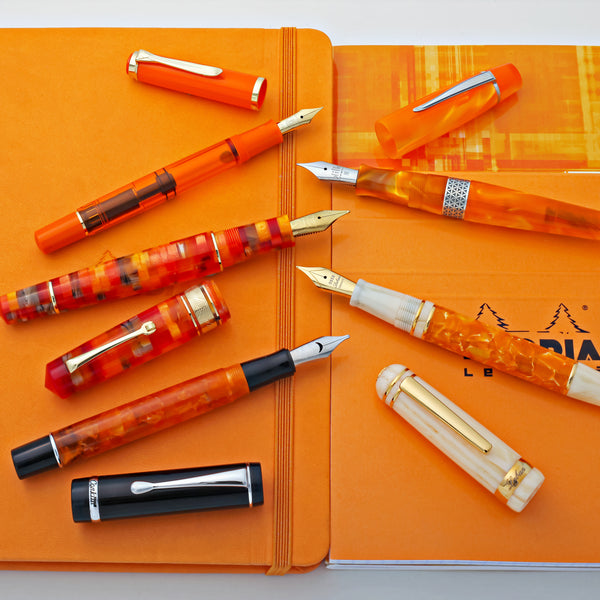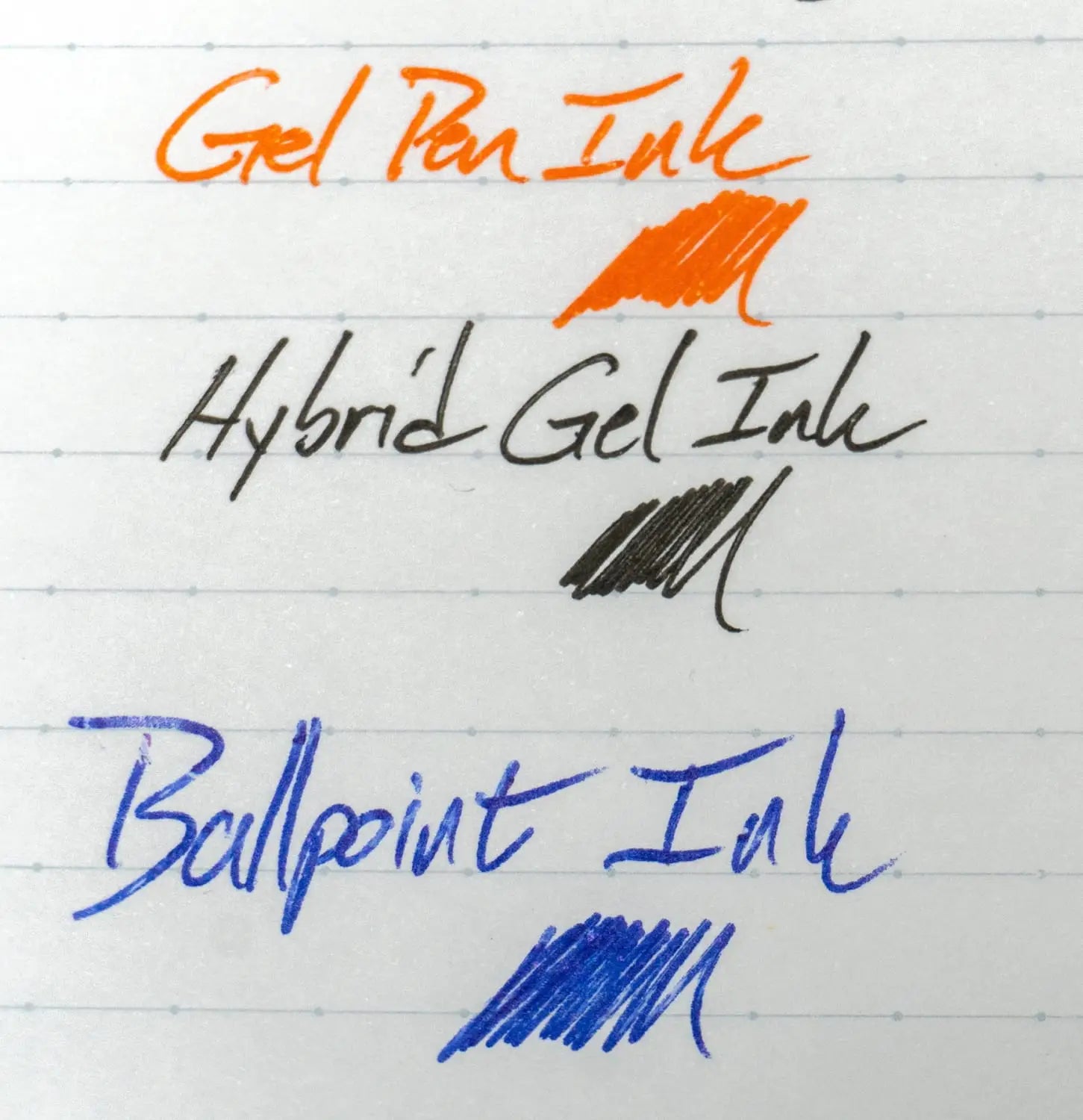Let’s talk ink! It’s the thing that ties all pens together and it’s the thing that we stare at, obsess over, and write with. Ink is some color plus some sort of base. The parts of that equation can vary wildly and that means that not every ink is suitable for every application. Let’s look at some different types of ink and talk about what they’re good for.
Different Types of Pen Ink, And Their Uses
Writing samples using Gel Pen Ink, Hybrid Gel Ink, and Ballpoint Ink. These are inks you would commonly find in retractable ballpoint/rollerball pens.
Oil-based Inks
The modern ballpoint was developed in the 1930s by László Bíró. The ink flow is regulated by a ball at the tip of the pen and the most common sorts use an oil-base to suspend their dyes. Thickeners in the ink keep it from sloshing around in the pen or flowing as freely as water-based inks. That ink is delivered to the paper by a small rolling ball in the tip of the pen. They’re convenient, cheap, and they write for a very long time. They write on all sorts of papers, and they come in many colors.
Related: How does a ballpoint pen work?
All this is not to say that they’re the perfect writing instrument. Not all colors work well as a ballpoint ink (greens never seem to look very good), and the restricted flow of an oil-based ink will sometimes make the ballpoint line look streaky or skippy. This is more common in wider ballpoints like those at 1mm width or above, but it can happen in the finer points, too.
Ballpoints are usually the second pen in my pocket. They scribble receipts. They write notes. They work on just about any paper without complications. They aren’t exciting, but they’re versatile and useful to have on-hand.
Shellac-Based Inks
India inks are very dense and they look great on the page. They’re often waterproof and lightfast. These inks make a very dark mark, and they stick around for the long haul. It’s used in art, calligraphy, and for writing things that need to pass the test of time. Unfortunately, the shellac that makes it so excellent in those ways does not play well with the feeds in fountain pens or the balls in rolling writers. Once it dries, you’ll have a devil of a time making that pen work again. If it ever does. Only use shellac inks in dip pens or something else you can wash with acetone.
Water-Based Inks
This is a category that will need to be sub-divided. There are more of them than any other type, and they’re used in more pens than the other categories. You’ll find them in fountain pens, rollerball pens, and gel pens.
Iron gall inks are a very old technology. There are existing documents from the 4th Century written in iron gall inks. They stick around. Unfortunately, the gallic acid that gives it its name eventually eats the materials that you write on. Slowly, though, so don’t worry. You’ve got a very long time before you have to worry about your work eating your medium. They can also be hard on your writing instruments, and I’m only aware of them being used in fountain pens. This acidic property varies, but inks like Rohrer & Klingner Salix (my favorite iron gall bottled ink) register a pH of ~1.5. That’s somewhere between stomach acid and vinegar. It’s not acidic enough to hurt you, but I only use that ink in gold nibs because they won’t react to the acid in the ink like your steel nibs might. These inks have great water resistance, and they generally oxidize as they interact with air so you get an interesting color-changing effect.
Pigmented inks suspend particles of pigments in the liquid of the ink instead of dissolved dyes. Gel rollers (like the Sakura Gelly roll or the Pilot G2) use pigments in a gel to give you an extremely smooth writing experience with a vast array of color options including shimmers and inks that look metallic. Some fountain pen inks use pigments for water resistance, and they can sometimes give you a bit of a matte appearance when they dry on the paper.
These are useful in any number of ways. They’re used for art, keeping records, and general writing. The colors are great, and many of the gel refills can be used in many different pen bodies to class up the writing instrument beyond their original form.
Pigmented fountain pen inks like those from Kala, Sailor, and Platinum might require a little more attention than a dye-based ink, but only maybe. I’ve had pigmented inks in fountain pens for years at a time without any issues. If they dry out in your pen, though, they can take some time to clean.
Gel inks are excellent for drawing, writing notes, and most other uses. The main drawback to this variety of ink is that it can take a long time to dry. They’ll work on receipt paper, but they need extra time to dry, and they can smear if you touch them too soon.
Even water-based fountain pen ink can have many sub-varieties of styles, including those that shimmer, sheen, and are waterproof.
Water-and-dye-based inks are the most common sort of ink. They use a dye component dissolved in some sort of liquid along with other things like wetting agents and biocides. The water in the formula makes them far more liquid than the oil-based ballpoint inks we discussed earlier. The exact compositions of inks are a guarded secret that you’d be lucky to pry from the minds of ink-makers. You’ll find these kinds of inks from major pen brands like Waterman or Pilot as well as from small boutique fountain pen ink-makers around the world, and they come in myriad colors and qualities. They might contain shimmers. They might be highly saturated and produce a flashy sheen when you write with them. They might have a lower saturation and produce shading in your letters. Some of them boast impressive water resistance and permanence.
Rollerball pens work like their ballpoint siblings, but they use a water-based ink instead of an oil-based one. That means that the ink flows more freely, and you won’t see the streaks or skips that you get from a ballpoint. The flip side of this is that this free-flowing ink is more likely to bleed through papers or into your pockets.
Different ink types are good for bad paper or good paper or even different pens and nibs. The variety that is available is also what makes it hard to generalize about. Two things you can generalize though: There are nearly endless options in this category, and you shouldn’t expect to sign your receipt with a fountain pen or a rollerball unless you have some time to wait for it to dry. They can’t soak into that thermal paper, and that’s inconvenient.
Hybrid Inks
These inks are generally found in some combination of water/gel/oil inks. They’re blended to get some combination of features that each type lacks on its own. Gel smoothness, roller density, and oil permanence. I use the “emulsion ink” of the Zebra Surari and the pigmented Pentel Hybrid Technica the most in this category. Each seem to have a feel somewhere between gel and ballpoint.
What’s the perfect ink for all situations? There isn’t one! Different tools are for different uses. It means that I almost always carry (at least) two pens. One fountain pen (because they make me happiest) and one gel or ballpoint (because sometimes you need to scribble a note, sign a receipt, or lend out a pen). Finding the perfect combination of properties is part of the fun in the pen hobby. What is your perfect combo?
Main Types of Pen Ink
The world of pen inks is as diverse as it is colorful, offering a variety of options to suit any writing task or artistic endeavor. Understanding the main types of pen ink is crucial for selecting the right ink for your needs. Let's explore the characteristics of fountain pen ink, ballpoint pen ink, rollerball pen ink, and gel pen ink.
Fountain Pen Ink
Fountain pen ink is primarily water-based, allowing for a smooth flow and easy glide over paper. This type of ink is known for its vibrant colors and the ability to create beautiful shading and sheening effects. Fountain pen inks are ideal for those who prefer a traditional writing experience and are available in a wide range of colors, including dominant industry ink for sale. However, they require regular maintenance of the pen to prevent clogging and are not waterproof unless specifically formulated.
Ballpoint Pen Ink
Ballpoint pen ink uses an oil-based formula, providing a thick and viscous consistency that allows for long-lasting writing without the need for frequent refills. The oil-based ink dries quickly on paper, reducing the risk of smudging. This makes ballpoint pens highly versatile and suitable for everyday use, from jotting down notes to filling out forms. Despite their practicality, ballpoint inks offer a limited color palette compared to other types.
Rollerball Pen Ink
Rollerball pen ink combines the best of both worlds, utilizing a water-based formula that flows more freely than ballpoint ink, resulting in a smoother writing experience akin to that of a fountain pen. Rollerball inks provide vivid colors and are excellent for detailed work, but they can take longer to dry and may bleed through thin paper.
Gel Pen Ink
Gel pen ink stands out for its unique composition, incorporating water-based ink with a gel substance to achieve a highly pigmented and vibrant output. Gel pens offer a wide array of colors, including metallics and pastels, making them a favorite for artistic projects and personalization. The thicker ink formula allows for smooth writing and bold lines, though it requires a bit more drying time to prevent smudging.
How to Choose the Right Ink for Your Needs
Selecting the right ink depends on several factors, including the writing surface, the desired durability of the writing, and personal preference for writing smoothness and ink color. For professional documents or artwork that requires longevity, consider waterproof and fade-resistant inks. For everyday writing, oil-based ballpoint inks offer convenience and reliability. If you prioritize writing pleasure and color variety, water-based fountain or gel inks might be your best choice, though it's important to consider if fountain pen ink expire over time. Always consider the paper quality, as some inks may bleed through or feather on lower-quality papers.




